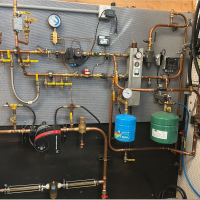Testing a Taco i100C3R-1 Mixing Valve? -- SOLVED
Hi, we have a Taco i100C3R-1 series mixing valve for our main floor in-floor hydronic heat. Not getting much heat from it, not quite sure whether it's restricted flow or a mixing valve problem. How do I check the valve?
Pressing the black knob and rotating for manual control multiple turns didn't come up against a stop. What do these look like inside, a ball valve? A gate valve?
One idea is unplugging the control box and using manual control, see what kind of output I can get. Though if the ball(?) is plugged up, that will give a false "didn't make a difference, it's not the valve" indication.
Comments
-
-
That Taco I100C3R can be used on a 2 way, 3 way, or 4 way valve. I wonder what valve you have? As I recall there is a ball inside those valves that is activated by the I100C3R motor. That ball can turn 360° with no stop. Your valve may be just fine, but the sensors, piping, settings, and/or wiring may not be correct. Do you know who installed the valve? Has it ever operated properly to your knowledge?
Edward Young Retired
After you make that expensive repair and you still have the same problem, What will you check next?
2 -
It looks like this motor is around 20 years old, and it has power (green LED) and I am assumming it has worked for all this time.
Of course with the photo, I do not see the sensors connected to it. The sensors are a 10k series sensor and to make sure they are working properly, you need to get your multi-meter, and do an ohm test on the sensors. You need to know the approximate air temp where the sensor is located, and check they are reading the correct air temp.
Dave Holdorf
Technical Training Manager - East
Taco, Inc
2 -
Thanks for the advice!
The system was working previously for many years.
3-way setup. The thermistor sensors seem to be functioning, using a Fluke 27 (1%) multimeter. The resistance of the one on the pipe out of the meter shifted as expected as the pipe cooled.
The mixing valve setup seems proper, per the Taco spec sheet; a circulation pump is fed by the mixing valve, which has hot and cold feeds. There is some heat flow; the pipes into and out of the pump do get warm, but not sufficient flow. So it seems unrelated to the valve.
Considering adding flow meters.
I tried flushing and checking the in-floor pipes by opening the spigot on the return pipe (closing the shutoff to the main return line); quite a lot of flow. So I don't think the in-floor pipe or the feed to the pump is blocked.
This suggests a test of the return below that point.
Possibly air? I haven't yet found an air eliminating valve on that floor, though I did purge air on the floor above. I'll look again.
Recent issues:
1. Pressurization: the make-up water feed was routed into the bottom port of the main air eliminator (Spirovent; opened it up to examine and it's in excellent shape. Cleaned out some black gunk). The vertical length of pipe (up-flow) had become clogged with rust from the water feed components, intermittently blocking the flow, with no cleanout (there's one now). The screen had corroded out in the wye filter preceding the regulator, which I opened up and cleaned up. Rebuilt the pressure regulator a few years ago; however the real problem was the intermittent pipe clog.
2. Replaced a clicking circulation pump.
3. An added magnetic filter got filled up and caused a blockage, well away from the mixing valve. I wonder whether this might have caused other issues, or is this a post-hoc, pocter-hoc ('after, therefore because of ') logical error?
There have been a lot of boiler issues (Buderus GB142) mostly caused by the blowers having a non-replaceable seal going out every few years. I had to replace the heat exchanger a few years ago (made the mistake of telling the local service company, who now won't touch it). However the boiler is currently operating well. We have hot water.
0 -
It should be simple to test the pressure into and out of the in-floor loop; put a pressure gauge on an adapter to the hose threads. That should help indicate whether and where any blockage is.
Anyone know what a typical range is for the pressure drop across an in-floor loop? Can't be a lot, given the low horsepower of the circulation pumps.
Which means a differential pressure gauge would be best.
0 -
Thank you for your assistance!
As far as I can tell, the valve is functioning correctly; it moves, and there's no leakage. It's more a flow issue. So there's a blockage somewhere in the system. I know there were rust chunks from the make-up water feed.
The body is soldered in; is there a way to inspect for and clear debris without cutting pipes? If so, if I undo screws and discover that a gasket or O-ring has aged or is damaged, are replacement seals available?
Any chance of a picture of the ball so I can tell how likely a clog is? Guessing it has to be a kind of dual pipe-elbow shape that allows flow from the two opposite-side sources; probably has narrow passages.
0 -
Has the valve been removed before you started looking at it and wanting to test ? If so , it is possible that the actuator was not put back on correctly . The power and sensor terminals should be directly over the Supply pipe inlet . Just something to check . Check the dipswitches also
You didn't get what you didn't pay for and it will never be what you thought it would .
Langans Plumbing & Heating LLC
732-751-1560
Serving most of New Jersey, Eastern Pa .
Consultation, Design & Installation anywhere
Rich McGrath 732-581-38331 -
-
Found the main floor air purge; no air came out. It appears not to be trapped air.
0 -
-
Solved: appears to have been sludge in a pipe.* Also the make-up water pipe, which was plumbed into the bottom of the Spirovent with no clean out, was plugged with rust.
A useful technique: with the system turned off, close valves to isolate the flow to a single path. Open a drain (into a 5 gallon bucket; a short hose used ONLY for this (as it will have traces of sludge) is helpful) and open the drain until sludge stops coming out.
May be less confusing to shut off the make-up water feed first, and count on the pressure accumulator for flow. Refill the accumulator as needed.
If there are multiple flow paths (if you don't close valves), water will pass through the non-clogged pipes, go around any clogs, and not push the sludge out of any clogged pipes.
* Always hard to tell exactly what happened inside a system of opaque pipes. But sludge came out, and it started working after this.
1 -
I would recommend now look for leaks in the system . Are any of the pipes ran in a slab ?
There was an error rendering this rich post.
0 -
If a lot of rust or sludge came out of the air sep, you might split it open and check the media. It is not uncommon to see them badly sludged in some systems. Non barrier pex or other radiant tube, for example.
When they plug this badly you need to use a nylon brush. Or replace the media.
This is not the seps fault, but a water quality issue.
Bob "hot rod" Rohr
trainer for Caleffi NA
Living the hydronic dream2 -
That's a nasty one ..
There was an error rendering this rich post.
0
Categories
- All Categories
- 87.3K THE MAIN WALL
- 3.2K A-C, Heat Pumps & Refrigeration
- 61 Biomass
- 429 Carbon Monoxide Awareness
- 120 Chimneys & Flues
- 2.1K Domestic Hot Water
- 5.8K Gas Heating
- 114 Geothermal
- 166 Indoor-Air Quality
- 3.7K Oil Heating
- 77 Pipe Deterioration
- 1K Plumbing
- 6.5K Radiant Heating
- 395 Solar
- 15.7K Strictly Steam
- 3.4K Thermostats and Controls
- 56 Water Quality
- 51 Industry Classes
- 50 Job Opportunities
- 18 Recall Announcements








